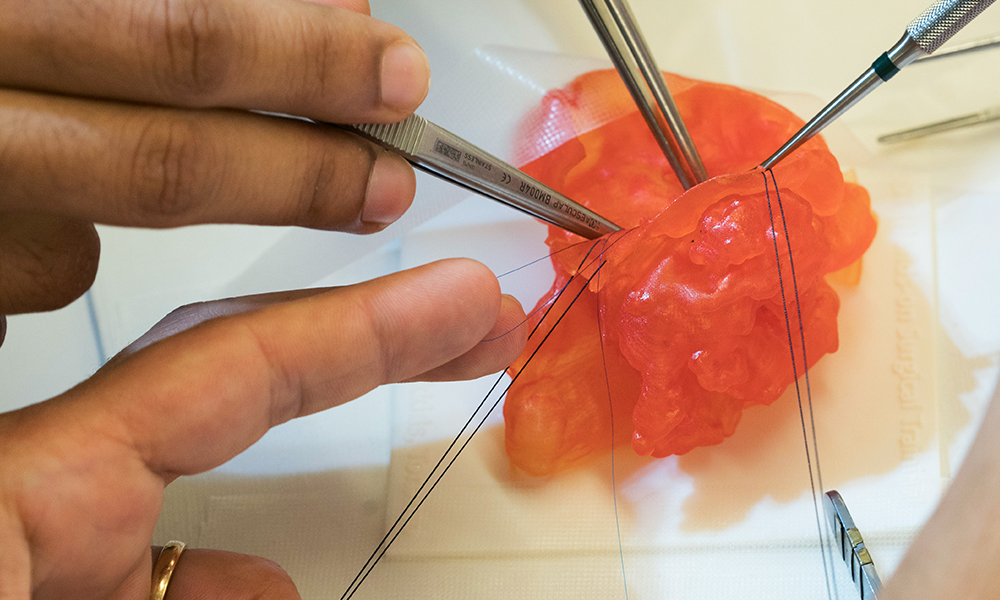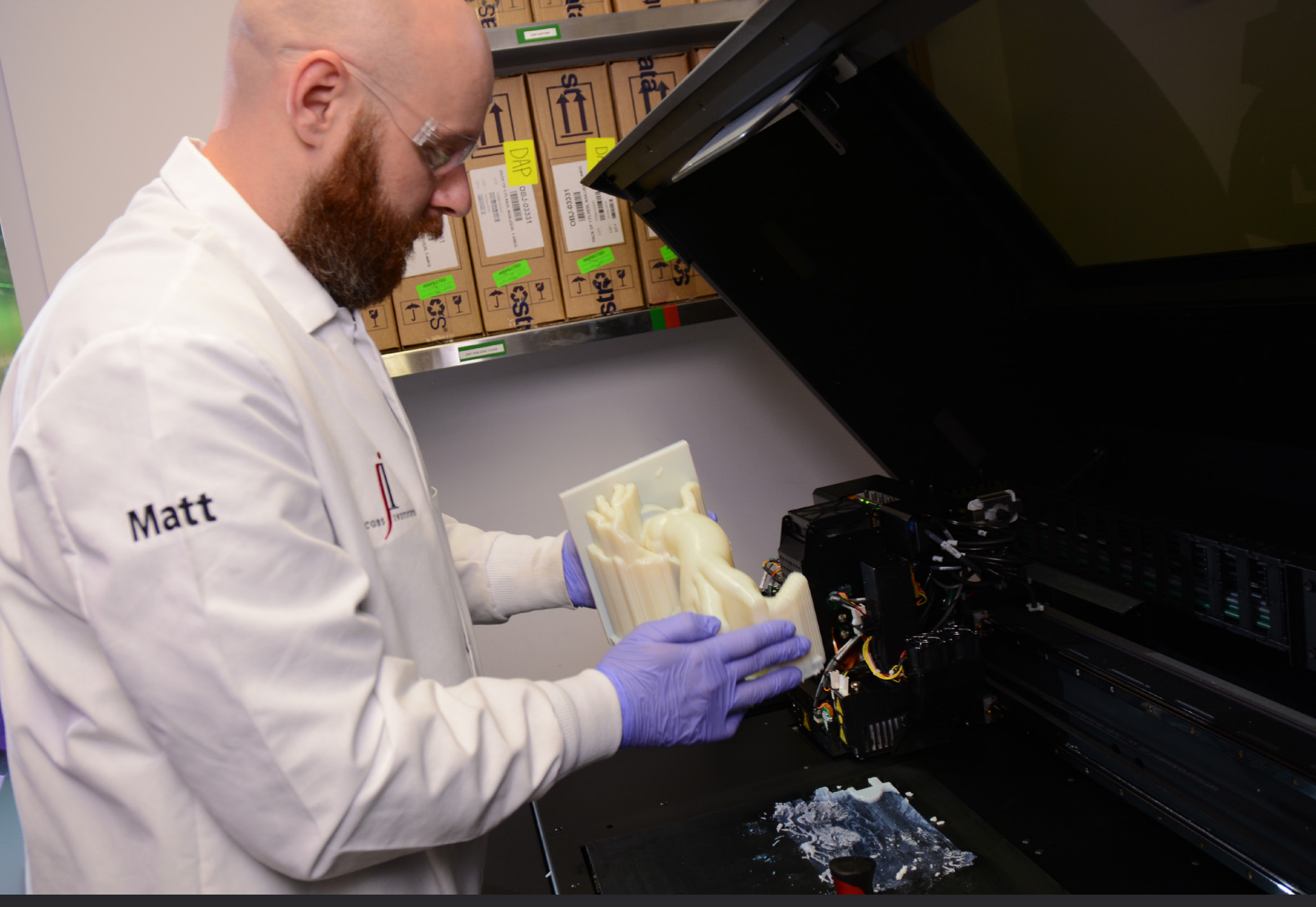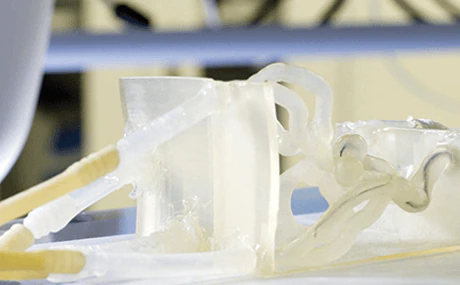Stratasys Direct Manufacturing announced the opening of a dedicated healthcare print center at its recently inaugurated PolyJet Design and Print Center in Eden Prairie, Minnesota. The new addition expands the company’s on-demand offerings to the healthcare industry to include anatomical modeling, full-service anatomical model design, and consulting services, including design transfer and process validation. This is one of several announcements made by the industrial 3D printing manufacturer at the RAPID + TCT 2021 conference, which ran from September 13 through 15 in Chicago.
The Healthcare Print Center in Eden Prairie has Stratasys J750 Digital Anatomy printers, which allow company engineers to produce life-like, 3D printed medical and dental anatomical models for medical device manufacturers and healthcare providers. Launched in November 2019, the J750 Digital Anatomy printer creates human anatomy models that mimic bone, vasculature, and organ tissues’ actual feel, responsiveness, and biomechanical properties to an unprecedented level of realism. These features allow customers to recreate pathologies and minimize the use of cadavers or animals for clinical trials and surgical training.

Stratasys J750 Digital Anatomy can help standardize surgical skills and delivery of care by practicing on the most accurate representation of the targeted pathology. Image courtesy of Stratasys
In the first 13 weeks of operation, as part of an invite-only beta service for top medical device manufacturers, Stratasys Direct has already 3D printed over 1,000 models, with each machine running more than 120 hours a week. In addition, working alongside its beta customers, Stratasys Direct created anatomical models for product demonstrations, physician surgical training events, and internal product development activities, hoping to open new possibilities for complex, anatomically accurate models at less cost than traditional manufacturing methods.
Hospitals, healthcare providers, and medical schools already use these lifelike 3D models for device testing, medical training, or surgical preparation and consultation, including practice dummies, educational aids, and preoperative planning. In fact, Stratasys Americas President Rich Garrity said the addition of Digital Anatomy printers to Stratasys Direct would offer companies with previously limited access to these printing capabilities the chance to use its manufacturing services for 3D printing exact anatomical models they need.

Spinal pedicel screw insertion 3D printed with Stratasys J750 Digital Anatomy platform. Image courtesy of Stratasys.
For example, users can choose the printer’s pre-programmed cardiac or vascular applications, automatically selecting the materials needed based on the settings chosen for a specific reproduction, allowing what Stratasys describes as an “accurate experience of procedures,” such as cutting and suturing, device placement and patching. The machine can produce cardiac models that replicate very fine anatomy, like cordae tendinae, valve leaflets, and annuli or replicate vascular models’ feel, function, and dimensions that recreate both healthy and diseased vessels.
Known for pursuing next-generation technologies to help treat vascular disease, the Jacobs Institute (JI) in Buffalo, New York, has leveraged 3D printing for years to create realistic medical models that can validate new devices and help medical teams prepare for difficult procedures. Now the JI relies on Stratasys J750 Digital Anatomy platform and materials to achieve a new level of realism. In fact, the American-Israeli firm said three new materials specifically designed for medical modeling applications set the Digital Anatomy printer apart from other solutions.

Jacobs Institute expert removing a vascular model from Stratasys J750 Digital Anatomy printer. Image courtesy of Jacobs Institute/Stratasys.
The niche of medical model 3D printers is dominated by a group of renowned companies in the industry, including Stratasys and its J750; Ultimaker’s S5 printer, which is certified by Materialise; Mimaki’s popular printers used for medical modeling; BCN3D’s professional desktop FFF printers which help doctors fabricate biomodels; and a handful of companies that have a long history developing medical models like EnvisionTEC (which was acquired by Desktop Metal early in 2021), 3D Systems, and HP’s 3D printers.

Vascular models designed by the Jacobs Institute and 3D printed using Stratasys J750 Digital Anatomy. Image courtesy of Stratasys.
Using powerful Digital Anatomy software and materials like GelMatrix, a support substance designed for easy removal from vascular models with small inner diameters and thin walls, or the incredibly soft, translucent TissueMatrix material, ideal for replicating the look and feel of heart tissue that has helped healthcare providers improve surgical preparedness. The company even created a complex material that mimics porous bone structures, fibrotic tissues, and ligaments, providing realistic feedback when cutting and drilling. Dubbed BoneMatrix, it is ideal for orthopedic applications, a significantly increasing market within the healthcare industry.
A year after launching the J750 Digital Anatomy printer, Stratasys said it was successfully sold and installed at healthcare institutions and medical service providers in major markets across the globe, including Seattle Children’s Hospital, the U.S. Veterans Affairs (VA) Health Care System, Nicklaus Children’s Hospital in Miami, Medilife and BIO3DModel in Italy, and Tknika and AIJU in Spain.
Subscribe to Our Email Newsletter
Stay up-to-date on all the latest news from the 3D printing industry and receive information and offers from third party vendors.
You May Also Like
Further Understanding of 3D Printing Design at ADDITIV Design World
ADDITIV is back once again! This time, the virtual platform for additive manufacturing will be holding the first-ever edition of ADDITIV Design World on May 23rd from 9:00 AM –...
3D Printer Maker EVO-tech Reborn as NEVO3D — Once More With Feeling
EVO-tech was a 3D printing service and original equipment manufacturer established in 2013 and based in Schörfling am Attersee, Austria. The company produced high-quality material extrusion systems featuring linear bearings,...
3D Systems Brings 3D Printed PEEK Cranial Implant to the U.S. with FDA Clearance
For more than 10 years, 3D Systems (NYSE:DDD) has worked hand-in-hand with surgeons to plan over 150,000 patient-specific cases, and develop more than two million instruments and implants from its...
CDFAM Returns to Berlin for Second Annual Symposium
The second CDFAM Computational Design Symposium is scheduled for May 7-8, 2024, in Berlin, and will convene leading experts in computational design across all scales. Building upon the first event...































